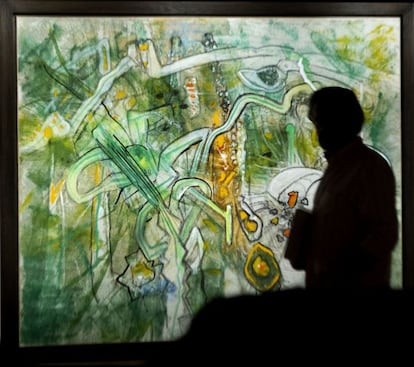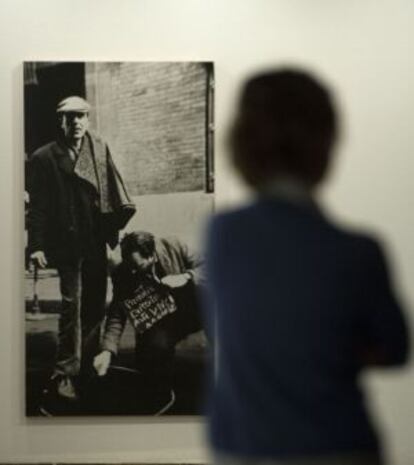Journey to the art of ‘Iberoamerica’
Valencia’s IVAM is offering a glimpse of works produced in the Americas over the last century

The Valencian modern art museum IVAM is offering a glimpse of the art produced in “Iberoamerica” over the last century through a selection of 127 works.
But this begs the question: what exactly is Iberoamerica? It is a 19th-century concept with an ideological and geo-strategic basis, and in any case, is “not very cultural at all,” explains art critic Fernando Castro, who curated Iberoamerican Art in the IVAM Collection.
At the time, the term helped raise awareness about a continent whose modern art had been stigmatized by English-speaking critics as a mere copy of the original material coming out of the hegemonic centers of culture.
“This overall visibility is what made us adopt the term Iberoamerican, with no desire to sound paternalistic, even though we are aware of the enormous differences you can find between an artist from Argentina and another one from, say, Cuba,” explains Castro. “That is why the show begins with Torres-García and his defense of Latin American art and his particular reinterpretation of the avant-garde movements.”
Indeed, Uruguayan artist Joaquín Torres-García’s influence pervades the entire exhibition. It was he who popularized the catchphrase “our North is the South,” which synthesized his critical views of Western art and his desire to appropriate indigenous values in his search for ties between Europe and the Americas.
IVAM was Spain’s first museum to buy work from Latin America before the boom”
His constructivist work opens a show that also features relevant artists such as Chile’s Alberto Matta, Cuba’s Wifredo Lam, Argentina’s Horacio Coppola, Guillermo Kuitka and Alberto Greco, Brazil’s Eduardo Kac and Sebastiao Salgado, and Mexico’s Alvarez Bravo and Hermanos Mayo.

The exhibition does not cover all Latin American art — it could not possibly. Instead, the point is to showcase the IVAM’s own holdings of Latin American art, built up over the course of its quarter century of existence.
“IVAM was Spain’s first museum to organize exhibitions of first-rate Latin American artists and to buy work before the boom, even if there were no systematic purchasing guidelines,” notes Castro. “But its international vision led IVAM to support artists such as Brazil’s Cildo Meirelles in the mid-1990s; he would later go on to win the Velázquez Prize and now he gets calls from the Tate Modern [in London] and [Madrid's] Reina Sofía.”
In fact, in 1980s Spain, the interest displayed by museums, collectors and galleries for Latin American art was “approaching zero.”
“I think we were caught out of step at a time when we were busy becoming European, and we turned our backs on Latin American art,” adds Castro. “Now we are tearing our hair out over it. We have missed our chance to become the country of reference, the bridge between the Americas and Europe, even if we are trying to regain lost ground.”
IVAM’s complete collection of Latin American art comprises 262 works by 41 artists. The 127 selected pieces represent painting, photography, sculpture, video art, design and installations. Around 20 percent of the material on display had never been on public view before.
Arte iberoamericano en la colección del IVAM. Until July 13 at IVAM, Valencia.
Tu suscripción se está usando en otro dispositivo
¿Quieres añadir otro usuario a tu suscripción?
Si continúas leyendo en este dispositivo, no se podrá leer en el otro.
FlechaTu suscripción se está usando en otro dispositivo y solo puedes acceder a EL PAÍS desde un dispositivo a la vez.
Si quieres compartir tu cuenta, cambia tu suscripción a la modalidad Premium, así podrás añadir otro usuario. Cada uno accederá con su propia cuenta de email, lo que os permitirá personalizar vuestra experiencia en EL PAÍS.
¿Tienes una suscripción de empresa? Accede aquí para contratar más cuentas.
En el caso de no saber quién está usando tu cuenta, te recomendamos cambiar tu contraseña aquí.
Si decides continuar compartiendo tu cuenta, este mensaje se mostrará en tu dispositivo y en el de la otra persona que está usando tu cuenta de forma indefinida, afectando a tu experiencia de lectura. Puedes consultar aquí los términos y condiciones de la suscripción digital.
Últimas noticias
Pinochet’s victims grapple with José Antonio Kast’s rise in Chile
Reinhard Genzel, Nobel laureate in physics: ‘One-minute videos will never give you the truth’
How Japan is trying to avert ‘digital defeat’
The complicated life of Francesca Albanese: A rising figure in Italy but barred from every bank by Trump’s sanctions
Most viewed
- Pablo Escobar’s hippos: A serious environmental problem, 40 years on
- Why we lost the habit of sleeping in two segments and how that changed our sense of time
- Charles Dubouloz, mountaineering star, retires at 36 with a farewell tour inspired by Walter Bonatti
- Trump’s obsession with putting his name on everything is unprecedented in the United States
- The Florida Keys tourist paradise is besieged by immigration agents: ‘We’ve never seen anything like this’









































